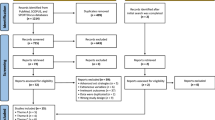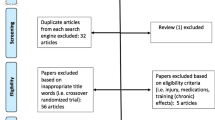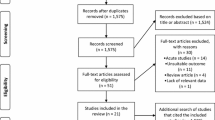Abstract
Purpose
Ultrasound is commonly used to measure changes in skeletal muscle morphology in response to both acute and chronic resistance exercise, but little is known on how muscle stiffness changes via ultrasound elastography, which was the purpose of this systematic review and meta-analysis.
Methods
The online data bases of Pubmed, Scopus, and Web of Science were each searched up until February 2020 and the data were analyzed using a random effects model.
Results
A total of eight studies (four acute and four chronic) met the inclusion criteria for the quantitative analysis. Following a single bout of exercise, muscle stiffness was increased within the first hour [ES: 1.52 (95% CI 0.14, 2.91); p = 0.031], but was no longer elevated when measured 2 days post-exercise [ES: 0.76 (95% CI − 0.32, 1.83); p = 0.16] or ≥ 7 days post-exercise [ES: 0.20 (95% CI − 0.53, 0.94); p = 0.58]. There was no impact of long-term resistance training on changes in muscle stiffness [ES: − 0.04 (95% CI − 0.24, 0.15); p = 0.653].
Conclusion
The primary findings from this meta-analysis indicate that muscle stiffness increases acutely following a single bout of resistance exercise, but does not change long-term with chronic resistance training when measured via ultrasound shear elastography. Given the small number of studies included in this review, future studies may wish to examine changes in muscle stiffness in response to both acute and chronic resistance exercise.



Similar content being viewed by others
References
Ozturk A, Grajo JR, Dhyani M, Anthony BW, Samir AE (2018) Principles of ultrasound elastography. Abdom Radiol (NY) 43:773–785
Jones DA, Newham DJ, Clarkson PM (1987) Skeletal muscle stiffness and pain following eccentric exercise of the elbow flexors. Pain 30:233–242
Davidson MJ, Nielsen PMF, Taberner AJ, Kruger JA (2020) Is it time to rethink using digital palpation for assessment of muscle stiffness? Neurourol Urodyn 39:279–285
Kerins CM, Moore SD, Butterfield TA, McKeon PO, Uhl TL (2013) Reliability of the myotonometer for assessment of posterior shoulder tightness. Int J Sports Phys Ther 8:248–255
Balci BP (2018) Spasticity Measurement. Noro Psikiyatr Ars 55:S49–S53
Brandenburg JE, Eby SF, Song P, Zhao H, Brault JS, Chen S et al (2014) Ultrasound elastography: the new frontier in direct measurement of muscle stiffness. Arch Phys Med Rehabil 95:2207–2219
Bensamoun SF, Ringleb SI, Littrell L, Chen Q, Brennan M, Ehman RL et al (2006) Determination of thigh muscle stiffness using magnetic resonance elastography. J Magn Reson Imaging: JMRI 23:242–247
Pillen S, van Alfen N (2011) Skeletal muscle ultrasound. Neurol Res 33:1016–1024
Muraki S, Fukumoto K, Fukuda O (2013) Prediction of the muscle strength by the muscle thickness and hardness using ultrasound muscle hardness meter. SpringerPlus 2:457
Rosskopf AB, Ehrmann C, Buck FM, Gerber C, Fluck M, Pfirrmann CW (2016) Quantitative shear-wave us elastography of the supraspinatus muscle: reliability of the method and relation to tendon integrity and muscle quality. Radiology 278:465–474
Dankel SJ, Loenneke JP (2018) Effect sizes for paired data should use the change score variability rather than the pre-test variability. J Strength Cond Res. https://doi.org/10.1519/jsc.0000000000002946
Šarabon N, Kozinc Ž, Podrekar N (2019) Using shear-wave elastography in skeletal muscle: a repeatability and reproducibility study on biceps femoris muscle. PLoS ONE 14:e0222008
Lacourpaille L, Nordez A, Hug F, Couturier A, Dibie C, Guilhem G (2014) Time-course effect of exercise-induced muscle damage on localized muscle mechanical properties assessed using elastography. Acta Physiol (Oxf) 211:135–146
Ochi E, Maruo M, Tsuchiya Y, Ishii N, Miura K, Sasaki K (2018) Higher training frequency is important for gaining muscular strength under volume-matched training. Front Physiol 9:744
Akagi R, Shikiba T, Tanaka J, Takahashi H (2016) A six-week resistance training program does not change shear modulus of the triceps brachii. J Appl Biomech 32:373–378
Akagi R, Tanaka J, Shikiba T, Takahashi H (2015) Muscle hardness of the triceps brachii before and after a resistance exercise session: a shear wave ultrasound elastography study. Acta Radiol 56:1487–1493
Mannarino P, Matta TTd, Oliveira LFd (2019) An 8-week resistance training protocol is effective in adapting quadriceps but not patellar tendon shear modulus measured by shear wave elastography. PLoS ONE 14:e0205782
Seymore KD, Domire ZJ, DeVita P, Rider PM, Kulas AS (2017) The effect of Nordic hamstring strength training on muscle architecture, stiffness, and strength. Eur J Appl Physiol 117:943–953
Agten CA, Buck FM, Dyer L, Fluck M, Pfirrmann CW, Rosskopf AB (2017) Delayed-onset muscle soreness: temporal assessment with quantitative MRI and shear-wave ultrasound elastography. AJR Am J Roentgenol 208:402–412
Hotfiel T, Kellermann M, Swoboda B, Wildner D, Golditz T, Grim C et al (2018) Application of acoustic radiation force impulse elastography in imaging of delayed onset muscle soreness: a comparative analysis with 3T MRI. J Sport Rehabil 27:348–356
Niitsu M, Michizaki A, Endo A, Takei H, Yanagisawa O (2011) Muscle hardness measurement by using ultrasound elastography: a feasibility study. Acta Radiol 52:99–105
Yanagisawa O, Niitsu M, Kurihara T, Fukubayashi T (2011) Evaluation of human muscle hardness after dynamic exercise with ultrasound real-time tissue elastography: a feasibility study. Clin Radiol 66:815–819
Yanagisawa O, Sakuma J, Kawakami Y, Suzuki K, Fukubayashi T (2015) Effect of exercise-induced muscle damage on muscle hardness evaluated by ultrasound real-time tissue elastography. SpringerPlus 4:308
Miles MP, Clarkson PM (1994) Exercise-induced muscle pain, soreness, and cramps. J Sports Med Phys Fitness 34:203–216
Friden J, Sfakianos PN, Hargens AR, Akeson WH (1988) Residual muscular swelling after repetitive eccentric contractions. J Orthop Res: Off Publ Orthop Res Soc 6:493–498
Green MA, Sinkus R, Gandevia SC, Herbert RD, Bilston LE (2012) Measuring changes in muscle stiffness after eccentric exercise using elastography. NMR Biomed 25:852–858
Hoang PD, Herbert RD, Gandevia SC (2007) Effects of eccentric exercise on passive mechanical properties of human gastrocnemius in vivo. Med Sci Sports Exerc 39:849–857
Macaluso F, Isaacs AW, Myburgh KH (2012) Preferential type II muscle fiber damage from plyometric exercise. J Athl Train 47:414–420
Yavuz A, Bora A, Bulut MD, Batur A, Milanlioglu A, Goya C et al (2015) Acoustic radiation force impulse (ARFI) elastography quantification of muscle stiffness over a course of gradual isometric contractions: a preliminary study. Med Ultrason 17:49–57
Yoshitake Y, Takai Y, Kanehisa H, Shinohara M (2014) Muscle shear modulus measured with ultrasound shear-wave elastography across a wide range of contraction intensity. Muscle Nerve 50:103–113
Funding
None.
Author information
Authors and Affiliations
Corresponding author
Ethics declarations
Conflict of interest
Neither SD nor BR has any conflicts of interest to declare.
Ethical approval
This is a systematic review and the Rowan University Institutional Review Board has confirmed that our study did not need ethical approval.
Informed consent
Prior informed consent was obtained by the researchers of the studies included in this review.
Additional information
Publisher's Note
Springer Nature remains neutral with regard to jurisdictional claims in published maps and institutional affiliations.
Rights and permissions
About this article
Cite this article
Dankel, S.J., Razzano, B.M. The impact of acute and chronic resistance exercise on muscle stiffness: a systematic review and meta-analysis. J Ultrasound 23, 473–480 (2020). https://doi.org/10.1007/s40477-020-00486-3
Received:
Accepted:
Published:
Issue Date:
DOI: https://doi.org/10.1007/s40477-020-00486-3




